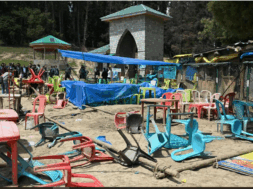
NEW DELHI, Mar 11: India on Monday joined the select group of nations with Multiple Independently Targetable Re-entry Vehicle (MIRV) technology with the Prime Minister Narendra Modi announcing the development of “Mission Divyastra” — an indigenously developed, landmark weapons system that alters the country’s geopolitic and strategic position and significantly changes the situation in south-east Asia.
The Agni-5 MIRV missile, developed by Defence Research and Development Organisation (DRDO) for over a decade, took its first flight on Monday. Mr Modi congratulated the scientists of the DRDO for the first flight test of a made-in-India Agni-5 missile, capable of deploying multiple warheads.
“Proud of our DRDO scientists for Mission Divyastra, the first flight test of indigenously developed Agni-5 missile with Multiple Independently Targetable Re-entry Vehicle (MIRV) technology,” PM Modi posted on ‘X’.
The new weapon system of DRDO has Multiple Independently Targetable Re-entry Vehicle (MIRV) technology, which ensures that a single missile can deploy multiple war heads and hit targets at different locations simultaneously.
The technology is currently possessed by a handful of nations and with its test, India has joined the select club, said government sources. MIRVs have been developed by the US, UK, Russia, France and China.
President of India Ms Droupadi Murmu said, “The first flight test of Agni V under Mission Divyastra marks a very important milestone in India’s march towards greater geo-strategic role and capabilities. The state-of-the-art technology developed indigenously is a firm step in the direction of India becoming Atmanirbhar. I convey my heartiest congratulations to the Team DRDO for this major achievement. I am sure they will keep moving apace in their quest for excellence and self-reliance.”
Dr V K Saraswat, former Director General of DRDO and currently Member Science and Technology, NITI Aayog, who was deeply involved with the development of the Agni-5 missile called it a “huge force multiplier” especially since India has an abiding no-first-use policy. In that scenario, he said, “executing a punishing second strike with lethal capabilities is critical and today India has achieved that next level.”
While developing a ballistic missile is a tough ask, developing one that carries multiple warheads that can be launched in different directions is a highly challenging task. An MIRV payload involves a single missile carrying several nuclear warheads, each programmed to hit a separate target. This means optimum use of a single missile and gives India the capability of targeting adversaries in the east and west within a 5,000-plus km radius.
To make this effective, the system is also equipped with indigenous avionics systems and high accuracy sensor packages, which ensure that the re-entry vehicles accurately reach the target points, sources said. It is suspected that the weapons system was tested within a range of 3,550 km, owing to the announcement of a no-fly NOTAM — meaning notice to airmen — in that range.
Dr Saraswat said each “baby missile within the mother missile” — in this case Agni-5 — has its own guidance and control system. “They can get launched some 300-400 km above the main target site and can hit independent targets,” he said.
In Divyastra, the basic missile is a three-stage Agni-5 missile, but the nose cone is modified to accommodate many micro-nukes, mini-nukes and even a big thermo-nuclear weapon, he added. Each MIRV acts like a targeted tactical weapon.
Agni has been part of India’s arsenal since the 1990s. Though India has conducted multiple tests on Agni-5 over the last few years, the new technology takes the country’s second-strike capability to a whole new level, sources said.
“If one incorporates a seeker on the missile, then one can even home in on moving targets like ships since each baby missile has its own attitude and guidance control software,’ Dr Saraswat explained.
The project director is a woman but her identity has yet been kept a secret. The weapon system is equipped with indigenous avionics systems and high-accuracy sensor packages which ensured that the re-entry vehicles reached the target points within the desired accuracy, sources said.
MIRV missiles permit a missile to deploy multiple nuclear warheads to different targets in contrast to a traditional missile that carries one warhead. The warheads on these missiles can be released at different speeds and directions. Some MIRVed missiles can hit targets as far as 1,500 kilometres apart.
Originally developed in the early 1960s, MIRV technology requires the combination of large missiles, small warheads, accurate guidance, and a complex mechanism for releasing warheads sequentially during flight.
The MIRVed missiles that are land-based are considered destabilising because these are much more significant targets than traditional missiles as several warheads can be taken out at once by an attacker.
The US was the first country to develop this technology. It deployed a MIRVed Intercontinental Ballistic Missile (ICBM) in 1970 and a MIRVed Submarine-Launched Ballistic Missile (SLBM) in 1971. The Soviet Union followed suit and developed their MIRV-enabled ICBM and SLBM technology by the end of the 1970s.
Presently, the US, UK and France have MIRVed SLBMs, China has MIRVed ICBMs while Russia uses both MIRVed ICBMs and SLBMs. As per reports, Pakistan is also experimenting with MIRV technology.
(Manas Dasgupta)














